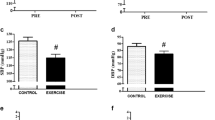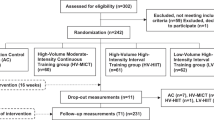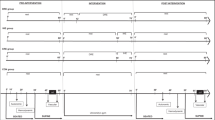Abstract
Reductions in blood pressure (BP) induced by exercise training may be associated with the acute reduction in BP observed minutes to hours following an exercise session, termed post-exercise hypotension (PEH). However, the magnitude and time-course of PEH, including the optimal exercise characteristics to maximise it, are still unclear. Using a randomised crossover design, 16 normotensive participants (median age (range) 22 (19–31) years; 50% female) undertook three different exercise sessions: sprint interval exercise (SIE, 30 × 8-s sprints with 32 s recovery), high-intensity interval exercise (HIIE, 15 × 1-min intervals at 90% peak heart rate (HR) with 1-min recovery), and moderate-intensity continuous exercise (MICE, 48 min at 65% peak HR). BP and HR were monitored before and up to 90 min following each session. The three exercise sessions each showed distinct PEH and of similar overall magnitude up to 90 min post exercise; however, there were distinct differences in the time-course. Systolic BP was lower 40 min after MICE compared to HIIE (−7.7 (−13.9 to −2.4) mmHg) and diastolic BP was higher 5 min after HIIE compared to SIE (8.5 (2.3–14.7) mmHg). MICE induced lower HR up to 40 min after exercise compared to HIIE and SIE. HIIE and SIE induced PEH of similar magnitude to MICE. A phasic or ‘W-shaped’ time-course of PEH observed following HIIE and SIE contrasted to a distinct ‘V-shaped’ PEH following MICE, indicating the physiological mechanisms driving BP regulation after exercise are influenced by exercise intensity.
This is a preview of subscription content, access via your institution
Access options
Subscribe to this journal
Receive 12 digital issues and online access to articles
$119.00 per year
only $9.92 per issue
Buy this article
- Purchase on Springer Link
- Instant access to full article PDF
Prices may be subject to local taxes which are calculated during checkout

Similar content being viewed by others
References
Benjamin EJ, Muntner P, Alonso A, Bittencourt MS, Callaway CW, Carson AP, et al. Heart disease and stroke statistics-2019 update: a report from the American Heart Association. Circulation. 2019;139:e56–528.
Olsen MH, Angell SY, Asma S, Boutouyrie P, Burger D, Chirinos JA, et al. A call to action and a lifecourse strategy to address the global burden of raised blood pressure on current and future generations: the Lancet Commission on hypertension. Lancet . 2016;388:2665–712.
Collaborators GRF. Global, regional, and national comparative risk assessment of 84 behavioural, environmental and occupational, and metabolic risks or clusters of risks for 195 countries and territories, 1990-2017: a systematic analysis for the Global Burden of Disease Study 2017. Lancet. 2018;392:1923–94.
Mills KT, Bundy JD, Kelly TN, Reed JE, Kearney PM, Reynolds K, et al. Global disparities of hypertension prevalence and control: a systematic analysis of population-based studies from 90 countries. Circulation. 2016;134:441–50.
Naci H, Salcher-Konrad M, Dias S, Blum MR, Sahoo SA, Nunan D, et al. How does exercise treatment compare with antihypertensive medications? A network meta-analysis of 391 randomised controlled trials assessing exercise and medication effects on systolic blood pressure. Br J Sports Med. 2019;53:859–69.
Pescatello LS, Franklin BA, Fagard R, Farquhar WB, Kelley GA, Ray CA. American College of Sports Medicine position stand. Exercise and hypertension. Med Sci Sports Exerc. 2004;36:533–53.
Mancia G, Fagard R, Narkiewicz K, Redon J, Zanchetti A, Bohm M, et al. 2013 ESH/ESC guidelines for the management of arterial hypertension: the Task Force for the Management of Arterial Hypertension of the European Society of Hypertension (ESH) and of the European Society of Cardiology (ESC). Eur Heart J. 2013;34:2159–219.
Umemura S, Arima H, Arima S, Asayama K, Dohi Y, Hirooka Y, et al. The Japanese Society of Hypertension Guidelines for the Management of Hypertension (JSH 2019). Hypertens Res. 2019;42:1235–481.
Whelton PK, Carey RM, Aronow WS, Casey DE, Collins KJ, Dennison Himmelfarb C, et al. 2017 ACC/AHA/AAPA/ABC/ACPM/AGS/APhA/ASH/ASPC/NMA/PCNA guideline for the prevention, detection, evaluation, and management of high blood pressure in adults: A report of the American College of Cardiology/American Heart Association Task Force on Clinical Practice Guidelines. Hypertension. 2018;71:e13–115. https://doi.org/10.1161/HYP.0000000000000065.
Sharman JE, Stowasser M. Australian association for exercise and sports science position statement on exercise and hypertension. J Sci Med Sport. 2009;12:252–7.
James PA, Oparil S, Carter BL, Cushman WC, Dennison-Himmelfarb C, Handler J, et al. 2014 evidence-based guideline for the management of high blood pressure in adults: report from the panel members appointed to the Eighth Joint National Committee (JNC 8). JAMA. 2014;311:507–20.
Pescatello LS. Exercise measures up to medication as antihypertensive therapy: its value has long been underestimated. Br J Sports Med. 2019;53:849–52.
Wegmann M, Hecksteden A, Poppendieck W, Steffen A, Kraushaar J, Morsch A, et al. Postexercise hypotension as a predictor for long-term training-induced blood pressure reduction: a large-scale randomized controlled trial. Clin J Sport Med. 2018;28:509–15.
Hecksteden A, Grutters T, Meyer T. Association between postexercise hypotension and long-term training-induced blood pressure reduction: a pilot study. Clin J Sport Med. 2013;23:58–63.
Liu S, Goodman J, Nolan R, Lacombe S, Thomas SG. Blood pressure responses to acute and chronic exercise are related in prehypertension. Med Sci Sports Exerc. 2012;44:1644–52.
MacDonald HV, Pescatello LS. Exercise and blood pressure control in hypertension. In: Kokkinos P, Narayan P, editors. Cardiorespiratory fitness in cardiometabolic diseases: prevention and management in clinical practice. Cham: Springer International Publishing; 2019. p. 137–68.
Keese F, Farinatti P, Pescatello L, Monteiro W. A comparison of the immediate effects of resistance, aerobic, and concurrent exercise on postexercise hypotension. J Strength Cond Res. 2011;25:1429–36.
Borg GA. Psychophysical bases of perceived exertion. Med Sci Sports Exerc. 1982;14:377–81.
Fecchio RY, Chehuen M, Brito LC, Pecanha T, Queiroz ACC, de Moraes Forjaz CL. Reproducibility (reliability and agreement) of post-exercise hypotension. Int J Sports Med. 2017;38:1029–34.
Carpio-Rivera E, Moncada-Jimenez J, Salazar-Rojas W, Solera-Herrera A. Acute effects of exercise on blood pressure: a meta-analytic investigation. Arq Bras Cardiol. 2016;106:422–33.
Perrier-Melo RJ, Costa EC, Farah BQ, Costa MDC. Acute effect of interval vs. continuous exercise on blood pressure: systematic review and meta-analysis. Arq Bras Cardiol. 2020;115:5–14.
Rossow L, Yan H, Fahs CA, Ranadive SM, Agiovlasitis S, Wilund KR, et al. Postexercise hypotension in an endurance-trained population of men and women following high-intensity interval and steady-state cycling. Am J Hypertens. 2010;23:358–67.
Angadi SS, Bhammar DM, Gaesser GA. Postexercise hypotension after continuous, aerobic interval, and sprint interval exercise. J Strength Cond Res. 2015;29:2888–93.
Scott JM, Esch BT, Lusina SJ, McKenzie DC, Koehle MS, Sheel AW, et al. Post-exercise hypotension and cardiovascular responses to moderate orthostatic stress in endurance-trained males. Appl Physiol Nutr Metab. 2008;33:246–53.
Costa EC, Dantas TC, de Farias Junior LF, Frazao DT, Prestes J, Moreira SR, et al. Inter- and Intra-individual analysis of post-exercise hypotension following a single bout of high-intensity interval exercise and continuous exercise: a pilot study. Int J Sports Med. 2016;37:1038–43.
Boeno FP, Ramis TR, Farinha JB, Moritz C, Santos VPd, Oliveira ARd, et al. Hypotensive response to continuous aerobic and high-intensity interval exercise matched by volume in sedentary subjects. Int J Cardiovasc Sci. 2019;32:48–54.
Halliwill JR, Buck TM, Lacewell AN, Romero SA. Postexercise hypotension and sustained postexercise vasodilatation: what happens after we exercise? Exp Physiol. 2013;98:7–18.
Chen CY, Bonham AC. Postexercise hypotension: central mechanisms. Exerc Sport Sci Rev. 2010;38:122–7.
Costa EC, Hay JL, Kehler DS, Boreskie KF, Arora RC, Umpierre D, et al. Effects of high-intensity interval training versus moderate-intensity continuous training on blood pressure in adults with pre- to established hypertension: a systematic review and meta-analysis of randomized trials. Sports Med. 2018;48:2127–42.
Clark T, Morey R, Jones MD, Marcos L, Ristov M, Ram A, et al. High-intensity interval training for reducing blood pressure: a randomized trial vs. moderate-intensity continuous training in males with overweight or obesity. Hypertens Res. 2020;43:396–403.
Wewege MA, Ahn D, Yu J, Liou K, Keech A. High‐intensity interval training for patients with cardiovascular disease—is it safe? A systematic review. J Am Heart Assoc. 2018;7.
Dempsey PC, Sacre JW, Larsen RN, Straznicky NE, Sethi P, Cohen ND, et al. Interrupting prolonged sitting with brief bouts of light walking or simple resistance activities reduces resting blood pressure and plasma noradrenaline in type 2 diabetes. J Hypertens. 2016;34:2376–82.
Dempsey PC, Larsen RN, Dunstan DW, Owen N, Kingwell BA. Sitting less and moving more: implications for hypertension. Hypertension. 2018;72:1037–46.
Larsen RN, Kingwell BA, Sethi P, Cerin E, Owen N, Dunstan DW. Breaking up prolonged sitting reduces resting blood pressure in overweight/obese adults. Nutr Metab Cardiovasc Dis. 2014;24:976–82.
Grace MS, Climie RE, Wheeler M, Lambert E, Sari CI, Rezai F, et al. Prolonged uninterrupted sitting impairs vascular function and increases biomarkers of atherosclerotic risk in overweight adults. Med Sci Sports Exerc. 2018;50:132–3.
Fecchio RY, Brito LCd, Peçanha T, Forjaz CLdM. Post-exercise hypotension and its hemodynamic determinants depend on the calculation approach. J Hum Hypertens. 2020. https://doi.org/10.1038/s41371-020-0297-5.
de Brito LC, Fecchio RY, Pecanha T, Lima A, Halliwill J, Forjaz CLM. Recommendations in post-exercise hypotension: concerns, best practices and interpretation. Int J Sports Med. 2019;40:487–97.
Dimeo F, Pagonas N, Seibert F, Arndt R, Zidek W, Westhoff T. Aerobic exercise reduces blood pressure in resistant hypertension. Hypertension. 2012;60:653–8.
Way KL, Lee AS, Twigg SM, Johnson NA. The effect of acute aerobic exercise on central arterial stiffness, wave reflection and hemodynamics in adults with diabetes: a randomized cross-over design. J Sport Health Sci. 2020. https://doi.org/10.1016/j.jshs.2020.02.009.
Inder JD, Carlson DJ, Dieberg G, McFarlane JR, Hess NC, Smart NA. Isometric exercise training for blood pressure management: a systematic review and meta-analysis to optimize benefit. Hypertens Res. 2016;39:88–94.
Smart NA, Way D, Carlson D, Millar P, McGowan C, Swaine I, et al. Effects of isometric resistance training on resting blood pressure: individual participant data meta-analysis. J Hypertens. 2019;37:1927–38.
Martinez M, Salvador P, Schoech L, Clark C, Gonzales JU, Rivas E. One session of high-intensity interval training acutely enhances the sensitivity of cerebral vasoreactivity post-exercise in young healthy males. FASEB J. 2020;34.
Acknowledgements
We would like to thank Balu Daniel for his technical assistance.
Author information
Authors and Affiliations
Contributions
MM, AW, KN, and GB recruited participants and collected study data. MDJ and AK designed the study, analysed, and interpreted the study data, and wrote the manuscript.
Corresponding author
Ethics declarations
Conflict of interest
The authors declare that they have no conflict of interest.
Informed consent
Informed consent was obtained from all individual participants included in the study.
Ethics statement
All procedures performed in studies involving human participants were in accordance with the ethical standards of the institutional and/or national research committee and with the 1964 Helsinki declaration and its later amendments or comparable ethical standards.
Additional information
Publisher’s note Springer Nature remains neutral with regard to jurisdictional claims in published maps and institutional affiliations.
Rights and permissions
About this article
Cite this article
Jones, M.D., Munir, M., Wilkonski, A. et al. Post-exercise hypotension time-course is influenced by exercise intensity: a randomised trial comparing moderate-intensity, high-intensity, and sprint exercise. J Hum Hypertens 35, 776–784 (2021). https://doi.org/10.1038/s41371-020-00421-3
Received:
Revised:
Accepted:
Published:
Issue Date:
DOI: https://doi.org/10.1038/s41371-020-00421-3



